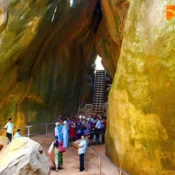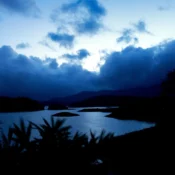
Mehrangarh Fort | Information | History | Timing
Mehrangarh Fort
Mehrangarh Fort holds the distinction of being a special place in Jodhpur due to its magnificent architecture and its associated history. It is one of the most formidable and magnificent forts in Rajasthan, it was built in the year 1459 by Rao Jodha. The fort is spread over an area of 5 km and is built on a 125-meter high hill on the outskirts of the city of Jodhpur.
It has seven gates, which can be used to enter the Mehrangarh Fort. These 7 gates were built by various rulers and in honour of the victory over the Bikaner and Jaipur armies.
The magnificent view of the city of Jodhpur can be seen from this fort, which resembles a blue carpet laid at the foot of the hill. Every ruler of Jodhpur has contributed to building this fort. Magnificent palaces can be seen within the fort. The main palaces located in the Mehrangarh Fort are Moti Mahal, Phool Mahal, Sheesh Mahal, Xena Yar, Takht Vilas and Jhanki Mahal. Two temples are also located inside the fort – Chamundi Devi Temple and Naganechiaji Temple, which are dedicated to Goddess Durga and Kuladevi respectively.
There is also a museum within the Mehrangarh Fort, which has a rich collection of palanquins, costumes, weapons, musical instruments, royal cradles, furniture and paintings.
Mehrangarh Fort: History
The fort of Mehrangarh owes its origin to Rao Jodha, the ruler of Mandore and the founder of the city of Jodhpur. When Rao Jodha decided to move his capital to a safe and elevated place in Jodhpur, he laid the foundation of this huge fort 1459, named Bhakursia aka The Mountain of Birds. The foundation stone of the fort was laid by the female warrior Sri Karni Mata.
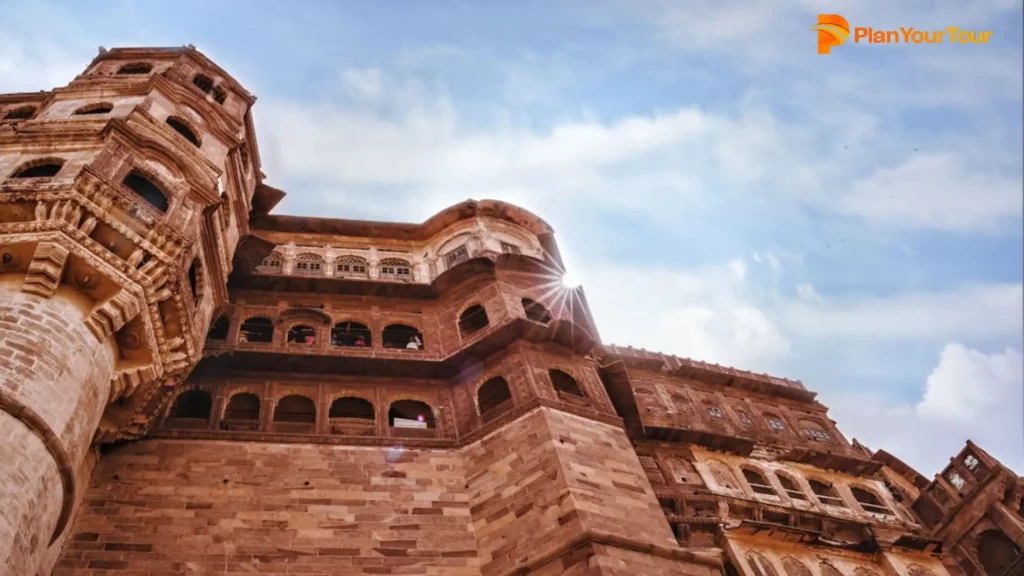
Legend has it that Rao Jodha was to be transferred to a monk named Chiraiya Nathji, the only resident of the hill, to build the fort. The angry Harmeet cursed that the fort would have to face water scarcity forever. To make him happy, the king built a temple and a house for him on the premises of the fort. Some local stories even say that Rao Jodha buried a common man named Raja Ram Meghwal alive in the foundation of the fort to reduce the effects of the curse. As the man voluntarily agreed to sacrifice his life, the king promised to take care of his family and continued to fulfil his promise with loyalty.
Over the years, the successors of Rao Jodha contributed greatly to the structure of the fort. They strengthened the walls and doors of the fort and also built new palaces and temples within the complex. It was in the 17th century, during the reign of Jaswant Singh of Marwar that the fort we see today was built.
Mehrangarh Fort Architecture
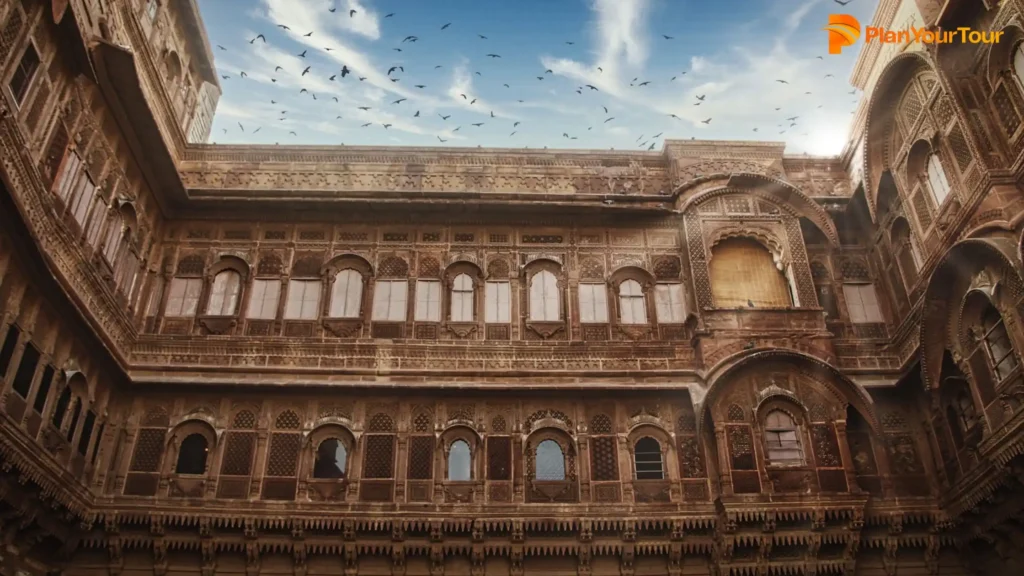
Mehrangarh is one of the best places to visit in Jodhpur, which is a celebration of various architectural styles. Starting in the mid-15th century to the 20th century, the fort and the structures within it were built over a long period of five centuries. So, its architecture reflects influences and elements from different eras, making it a unique attraction.
The fort is spread over an area of 5 km and is surrounded by walls that are about 117 feet long and 70 feet wide. In some places, the fort walls rise to a height of 120 feet, adding to its formidable structure. There are seven beautiful gates embellished on the walls of the fort, which have been built at different times for various reasons. The complex of the fort has many magnificently decorated palaces and temples.
Mehrangarh Museum
Mehrangarh Fort Museum has various galleries which are a wonderful collection of artefacts and decorative arts. The galleries at the Mehrangarh Fort Museum include:
Elephant Howard Gallery: Howrah (seats used for elephant riding) in the 18th and 19th centuries, with silver silver Hoda by Shah Jahan to Maharaja Jaswant Singh
Daulat Khana Gallery: Some magnificent treasures of this fort, including some monuments of Emperor Akbar.
Turban Gallery: Different types of turban are used by different communities and regions on different festivals and occasions in Rajasthan.
Palvin Gallery: A splendid collection of sedan including Pinjas (covered palanquin) and Rajat Khasa (lotus-shaped palanquin) to mention a few.
Painting Gallery: A good collection of miniature paintings and artwork related to the Marwar School
Cloth Gallery: Precious carpets, canopies, floor-spans, tent walls, textiles and accessories from various centuries
Sileh Khana or Arms Gallery: The swords of many kings and emperors, including the Khanda of Rao Jodha, weighing more than 7 pounds, and the swords of emperors Akbar and Timur
Wood Craft Gallery: A variety of artefacts are carved out of wood and adorned with gold polish and ivory.
Cradle Gallery: A rare collection of cradles that includes an electric cradle designed for the current king
Ziplining in Mehrangarh
Things to see in Mehrangarh Fort Complex
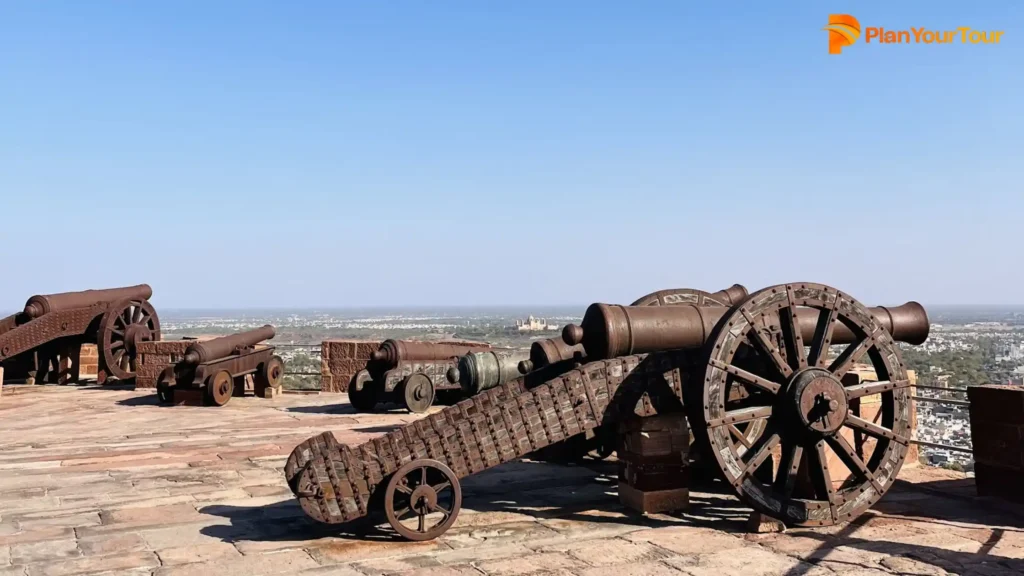
The majestic fort has a lot to offer to visitors. Top things to see in Mehrangarh Fort include:
- Sheesh Mahal or Hall of Mirrors, the bedroom of Maharaja Ajit Singh which is decorated with glasswork.
- Phool Mahal or the Palace of Flowers, an ornate reception hall built by Abhay Singh, dating back to the mid-18th century, its architectural style matches the palaces of Shah Jahan.
- Moti Mahal or the Palace of Moti is a beautiful chamber showcasing the glow of pearls. Here the queens would sit unseen and listen to the court proceedings.
- Takhat Vilas is a large interior room decorated with stained glass in the windows. This was the personal room of Takhat Singh.
- There is a Jayapol built-in 1806 by Maharaja Man Singh to commemorate his victories over the armies of Bikaner and Jaipur.
- Fatehpur built by Maharaja Ajit Singh in 1707 to conquer Mughal forces. It has spikes to prevent any attack by elephants.
- Dedh Kamagra Pol where the impact of cannons can be seen from the bombing by the invading Jaipur army.
- Emerita Pol one of the gates of the fort
- Suraj Pol, the gate that leads to the museum
- Loha Pol, the last gate leading to the main part of the fort
- Kirat Singh Soda’s Chhatri, an elaborate structure that marks the place where a soldier fell down from the fort in 1808
Chamunda Mata Temple built by Rao Jodha in 1460
Mehrangarh Fort, Jodhpur all Information:-
Location: Sodagaran Mohalla, Ratnada, Jodhpur, Rajasthan, 342006, India
Timings: 9 am to 5 pm
Entry Fee: 150 Rs Per person
Also Read: 8 Most Famous Shopping Places in Jodhpur – Street Shopping in Jodhpur

